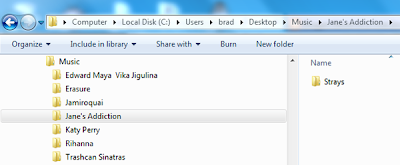 I spent a lot of time testing out some of the most popular Cloud File Storage software available and settled on using Sugarsync as my software of choice. There are two main reasons why I chose Sugarsync:
I spent a lot of time testing out some of the most popular Cloud File Storage software available and settled on using Sugarsync as my software of choice. There are two main reasons why I chose Sugarsync:(1) Unlike most of the other software, such as Dropbox, you don't have to create a separate folder to store your 'synced' data and manually drag your files to that folder. Sugarsync works much like Carbonite backup does. You install the software and designate which folders you wish to synchronize to the cloud.
(2) When sharing folders with other users, Sugarsync requires authentication to view the data. There are some Cloud File Storage software out there that does not require a username and password to view shared data. In my opinion, that is too big of a security risk.
The one thing that really bothers me about all Cloud File Storage solutions out there is their inability to synchronize network shared data. In the real world, IT Admins tend to store USER data on servers and configure user workstations to redirect their My Documents to these network folders. This allows IT Admins to be able to centralize storage, which makes data backup and restoration much simpler.
However, storing the data off of the workstation makes it nearly impossible to use programs like Dropbox or Sugarsync to synchronize this data. I assume one day, Sugarsync will release a version of software that will accomplish network syncing, but until then what do you do?
Well, I came up with a solution. By using Symbolic Links, you can get Sugarsync to sync data on a network shared drive. There are a couple of caveats to acknowledge about this process:
(1) Sugarsync does not 'watch' a symbolic linked folder like it does regular folders. If a new file or folder is added to the symbolic linked folder, Sugarsync does not automatically detect the new file or folder creation, which prevents the file from being synchronized. The Sugarsync software has to be shutdown and restarted. But once restarted, it detects the new file or folder, synchronizes it and begins watching it. If changes are made to those files or folders, Sugarsync will synchronize them. But if new files are created, you must repeat the process of restarting the Sugarsync software.
(2) Unlike locally stored folders, Sugarsync will not allow you to exclude files or folders from the Symbolic Linked Folder. This means all the data within this folder will be synced.
(*UPDATE* Sugarsync has released the Beta 2.0 software and it does allow you to exclude subfolders within the Symbolic Linked Folder.)
But if you can get past these two shortcomings, you should be able to get Sugarsync to sync network shared data with very little effort. Here is how it is done:
(1) Create a network shared folder. In my example, I have created a folder called 'SugarSyncTest', located on my Buffalo NAS device. The path to this folder is \\linkstation2\share\sugarsynctest
I added a TXT file and Folder to this network shared folder for testing purposes:
(2) Now, you need to create a folder on your local computer that will store the Symbolic Link. Sugarsync will not allow you to directly add a symbolic linked folder, so the link must be a subfolder of a folder that you will have Sugarsync use. In this case I created a folder called
C:\SugarSyncLink
(3) Open the Sugar Sync Manager software and add the folder that you created in step 2 by choosing Add Folders to SugarSync | Add More Folders and selecting the C:\SugarSyncLink folder. This folder must be syncing with SugarSync prior to creating the symbolic link to your network data.
(with the new Beta 2.0 software, you can simply drag and drop your folder to the Sugarsync management software)
(4) After creating the local folder, you will need to create a symbolic link that connects to that share. Start the symbolic link creation by launching the Command Prompt as Administrator:
(5) At the command prompt type this command:
mklink /D C:\SugarSyncLink\SugarNetData \\linkstation2\share\sugarsynctest
This command makes a Directory Symbolic Link called 'SugarNetData', located in the
C:\SugarSyncLink folder, which links to the network share of \\linkstation2\share\sugarsynctest
You would change \\linkstation2... to the path of your network share.
(6) If you navigate to the C:\SugarSyncLink\SugarNetData folder and open it, you will see the contents of the \\linkstation2\share\sugarsynctest folder.
(7) If you take a look at the newly added folder in the SugarSync manager, you will notice that it doesn't contain any data.
If you close SugarSync and re-open, it will begin the synchronization of the data within the network shared data.
Once the data is synced in Sugarsync, you can change it and those changes will automatically sync in real time. But if any new data is added to the folder, you will have to close Sugarsync and reopen again to sync this new data. A small price to pay to be able to synchronize network shared data.














